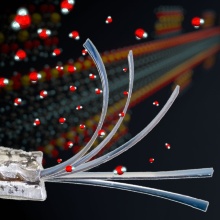Research groups led by construction mechanic Prof. Holger Steeb from Faculty 2's Institute of Applied Mechanics (Civil Engineering) and polymer chemist Prof. Sabine Ludwigs have developed active bilayer structures made of intelligent polymers based on the model of a flowering plant. These structures bend autonomously when exposed to moisture and then regain their original shape. They have also integrated the experimental results into a model that can be used to predict and control the curvature behavior. This was reported in the renowned journal Advanced Materials. The principle could be used, for example, for soft robot gripper arms or in biomedicine.
Ramonda myconi, the Pyrenean rock plate, delights not only with small purple flowers, but also the leaves have it in them: they consist of several layers, one of which can absorb water and thus swells, while others remain stable. In extreme drought, the water reservoir dwindles and the leaf bulges. If wetter times come again, the leaf regains its original shape by itself (autonomously).
Such behavior is also interesting for material science, namely for intelligent components that are supposed to exhibit continuous reversible behavior. This is the case, for example - keyword soft robotics - with soft robot gripper arms, which are supposed to exert movements thousands of times, surviving the change from dry to wet each time without damage.
Model enables reliable prediction of curvature
To arrive at such materials, researchers at the Department of Structure and Properties of Polymeric Materials (Prof. Sabine Ludwigs) and the Institute of Applied Mechanics (Civil Engineering) (Prof. Holger Steeb) at the University of Stuttgart took the physical properties and mechanical behavior of Ramonda myconi's leaves as a model and recreated a simple double-layer structure of polymers: a bending beam in which the variation in humidity triggers the curvature response. Since it is an active (mechanical) component, it is referred to as an actuator. They now tested the bending beam under different climates and described how the different parameters affect the water absorption capacity, the stiffness and ultimately the bending behavior. The researchers then integrated this data into a mathematical model that can be used to predict mechanical behavior. "The combination of mechanical characterization and a simple analytical model allows reliable prediction of actuator curvature. This is what makes our research so special," Sabine Ludwigs and Holger Steeb explain.
In the future, the two scientists plan to extend their research to multilayer structures as well as more complex geometries. In addition, they plan to investigate other triggers besides moisture, such as an electric field, which can be used to trigger the change.
Successful cross-faculty collaboration
The publication is the result of a very successful cross-faculty collaboration between natural sciences and engineering. In the process, the working groups led by Prof. Sabine Ludwigs and Prof. Holger Steeb brought together their complementary expertise in polymer chemistry, flexible electronics and knowledge of the mechanics of functional polymer materials. The impetus for the collaboration came from the now defunct transregional Collaborative Research Center TRR 141 (Design and Construction Principles in Biology and Architecture. Analysis, Simulation and Implementation). The results also benefit the Cluster of Excellence "Data-integrated Simulation Science" (SimTech) at the University of Stuttgart.
Translated with www.DeepL.com/Translator (free version)
| Contact | Prof. Holger Steeb, University of Stuttgart, Institute of Applied Mechanics (Civil Engineering) and Cluster of Excellence EXC 2075 SimTech, Pfaffenwaldring 7, +49 711 685-66029, holger.steeb@mechbau.uni-stuttgart.de |
|---|


